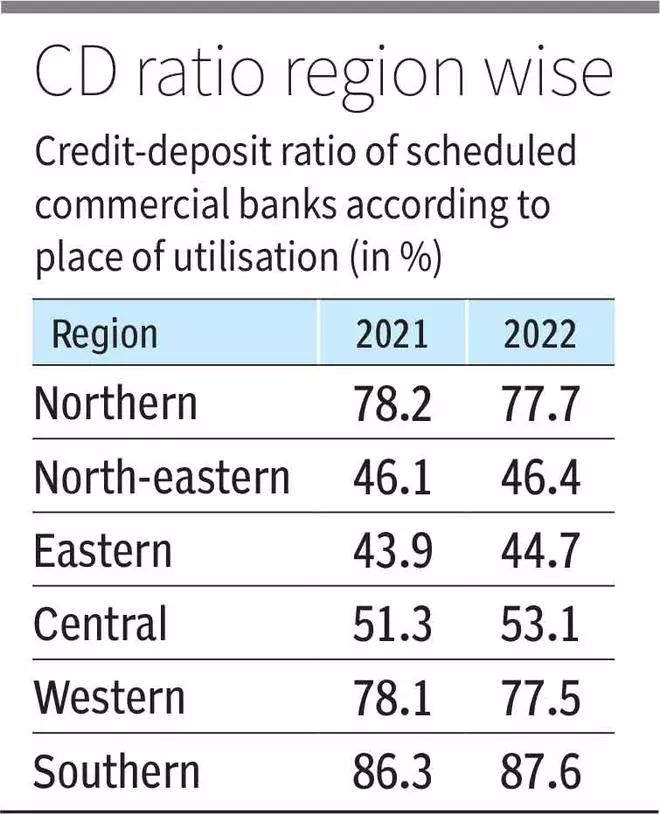Credit-Deposit (CD) ratio of the Northern and Western Regions declined in 2022 even as that of the North-Eastern, Eastern, Central and Southern Regions improved, as per the latest Reserve Bank of India (RBI) data.
This ratio indicates how much of each rupee of deposit goes towards credit markets in a particular region.
As per RBI’s data on State-wise C-D ratio of scheduled commercial banks according to place of utilisation, the Northern Region’s (NR) ratio declined from 78.2 per cent to 77.7 per cent.
Haryana, Himachal Pradesh, Jammu & Kashmir, Punjab, Rajasthan, Chandigarh, Delhi and Ladakh constitute the NR.
An interesting feature of the C-D ratio of NR is that Union Territories (UTs) of Jammu & Kashmir and Ladakh have shown good improvement with this ratio going up to 52.2 per cent (48.9 per cent in 2021) and 36.9 per cent (35.4 per cent), respectively.

Experts say this is probably a sign that economic activity is gradually picking up pace in these UTs after they were carved out of the Jammu & Kashmir State.
In the NR, States that saw a decline in C-D ratio are: Punjab (from 57.4 per cent to 56.5 per cent); Chandigarh (from 99.4 per cent to 91.4 per cent); and Delhi (from 96.6 per cent to 95.6 per cent).
States that saw improvement in C-D ratio are: Haryana (from 59.8 per cent to 60.7 per cent); Himachal Pradesh (from 32.0 per cent to 33.1 per cent); and Rajasthan (from 81.9 per cent to 83.4 per cent).
Other regions
The Central Region’s C-D ratio was up from 51.3 per cent to 53.1 per cent due to improvement in the ratios of Chhattisgarh (from 66.8 per cent to 70 per cent), Uttar Pradesh (from 44.2 per cent to 46.4 per cent) and Uttarakhand (from 36.7 per cent to 37.5 per cent). C-D ratio of Madhya Pradesh declined from 70.7 per cent to 70.4 per cent.
The Western Region’s C-D ratio was down from 78.1 per cent to 77.5 per cent as the ratios of Maharashtra and Dadra & Nagar Haveli declined to 77.8 per cent (from 79.2 per cent) and 51.2 per cent (52.4 per cent), respectively.
The Southern Region’s C-D ratio improved from 86.3 per cent to 87.6 per cent, with three States notching up triple-digit ratios — Andhra Pradesh (from 135.2 per cent to 142.7 per cent), Tamil Nadu (from 103.8 per cent to 103.7 per cent) and Telangana (from 99.3 per cent to 103.4 per cent).
The North-Eastern Region’s C-D ratio improved a tad from 46.1 per cent to 46.4 per cent, supported by rise in ratios of Assam (from 48.1 per cent to 50.7 per cent), Manipur (from 60.1 per cent to 66.3 per cent), Mizoram (from 42.2 per cent to 45.7 per cent) and Tripura (from 42.6 per cent to 43.3 per cent).
The Eastern Region’s C-D ratio rose from 43.9 per cent to 44.7 per cent on the back of rise in ratios of Bihar (from 41.2 per cent to 44.2 per cent), Jharkhand (from 31.5 per cent to 32.6 per cent), Odisha (from 42.9 per cent to 43.5 per cent), Sikkim (from 36.3 per cent to 41.8 per cent) and Andaman & Nicobar Islands (from 46.5 per cent to 51.1 per cent). C-D ratio of West Bengal, the largest State in the region, declined a shade to 49 per cent from 49.2 per cent, per the RBI data.
As per a 1992 RBI staff studies paper, while interpreting such a broad indicator as C-D ratio for measuring the inter-State disparities in banking development and the role of banking in economic activity, it is necessary to take cognisance of a number of factors such as the historical base in banking in different regions, the policies and programmes to reduce regional disparities and their achievements and the profiles of agricultural, industrial and infrastructural development in various States.
Stay connected with us on social media platform for instant update click here to join our Twitter, & Facebook
We are now on Telegram. Click here to join our channel (@TechiUpdate) and stay updated with the latest Technology headlines.
For all the latest For Top Stories News Click Here
